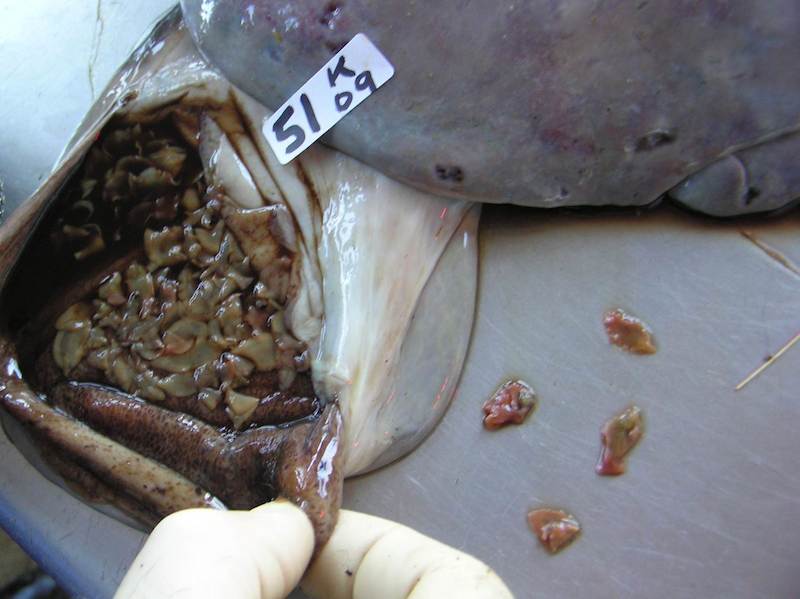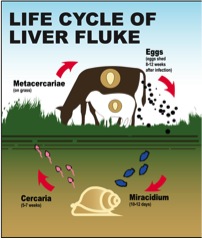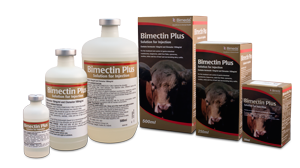Liver Fluke
(Fascioliasis)
What Is Liver Fluke?
Liver Fluke (Fascioliasis) is caused by a specific flatworm, known as Fasciola hepatica. This parasite has a complicated life cycle that typically takes from 9-20 weeks to progress from beginning to end. Immature stages of the liver fluke are also able to survive in a cyst-like structure, similar to Dictyocaulus. The encysted fluke can survive in this state for up to 2 years, particularly over mild winters. This has knock-on effects for control measures as it means that once fluke is established, control programmes must be followed year-in, year-out.
Liver fluke levels have been rising consistently in the UKIreland over recent years and farms on all types of land -including those on traditionally drier land - must now ensure fluke surveillance and control strategies are in place. The mild weather of recent winters coupled with the high rainfall in some recent summers has being ideal for high fluke and snail levels, and many abattoirs are reporting a trend of increasing liver condemnation.
What Is The Impact of Liver Fluke? If My Cattle Don’t Have Obvious Symptoms, Are They Fluke Free?
Even if your stock do not display obvious, clinical symptoms such as bottle –jaw, diarrhoea and weight loss, this does not mean your stock are fluke free.
Sub-clinical fluke in cattle causes reduced profitability due to lack of thrive, reduced food conversion efficacy, lowered fertility, increased susceptibility to other infections and reduced milk yield so it is important not to assume that your cattle are fluke-free.
How Big Is The Problem?
As a result of the extremely negative impacts on animal wellbeing and performance, liver fluke is a major economic issue for many UK cattle farmers. Inevitably issues such as impaired milk production, reduced weight gain and lowered fertility translate into serious costs for the farmer, and a 2003 study estimated that liver fluke costs the UK cattle industry £300 million each year.1 The same study estimated that fluke affects 377 cattle per 1,000 head. What’s more, UK experts predict that fluke infections will reach unprecedented levels within the next 60 years. With such sobering figures in mind, it is unsurprising that the effective control of liver fluke remains a top priority for farmers and animal health professionals in the UK.
As a result of the extremely negative impacts on animal wellbeing and performance, liver fluke is a major economic issue for many Irish cattle farmers. Inevitably issues such as impaired milk production, reduced weight gain and lowered fertility translate into serious costs for the farmer. The Animal Health Ireland Report, ‘Liver Fluke - The Facts’, noted that annually, liver fluke, ‘is estimated to cost at least €90 million to the Irish Industry’. The report also noted that, ‘liver fluke may cause a reduced meat production of up to 20% in cattle…and a reduction of up to 8% in cows’. What’s more, some experts predict that fluke infections will reach unprecedented levels within the next 60 years. With such sobering figures in mind, it is unsurprising that the effective control of liver fluke remains a top priority for farmers and animal health professionals in Ireland.
The Liver Fluke Life Cycle
The diagram below highlights the life cycle of the liver fluke.
The key stages in the life cycle of the liver fluke are:
- The adult liver fluke in the liver of its host produces eggs which pass onto the pasture
- These eggs hatch in damp, warm conditions; producing mobile larvae (miracidia) which then infect a certain species of snail
- The larvae multiply within in the snail and develop into another stage (cercaria), which emerge from the snail and settle on the pasture
- These then develop into a highly tolerant non-mobile stage (metacercaria) that can survive for at least a year. Once eaten by the cow these hatch and migrate to the liver.
1. R Bennett et al, Economic Assessment of Livestock Diseases in Great Britain, 2003



